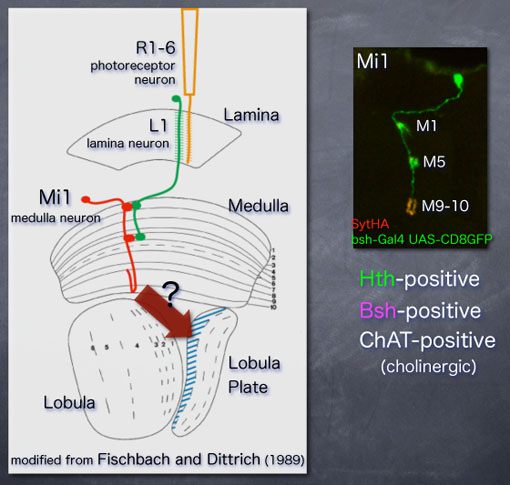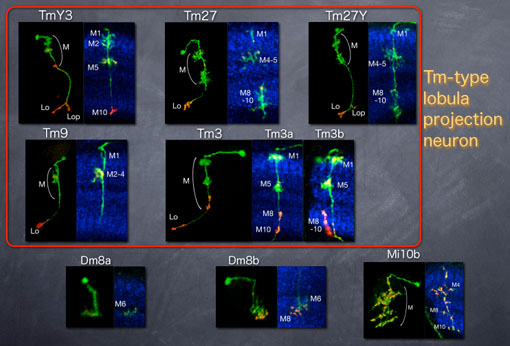          


 |
|
Projection patterns of medulla neurons |
| Generation of Gal4 drivers that reproduce concentric gene expression |
|
|
To visualize projection patterns of neurons expressing concentric transcription factors,
we generated Gal4 drivers that precisely mimic expression of hth, bsh and drf.
In the following slides, GFP expression was induced using these Gal4 drivers and
projection patterns of Hth, Bsh and Drf-positive neurons were compared.
|
|
|
| Projection patterns of Hth and Bsh positive neurons |
|
| |
Initially, we generated single cell clones expressing GFP under the control of hth-Gal4.
We found there are four types of Hth-positive neurons in the adult medulla.
In many cases, projection of Hth-positive neurons were restricted to the medulla neuropile, no projection to the lobula.
About 90% of Hth-positive neurons were the medulla intrinsic neuron, called Mi1.
As mentioned earlier, Bsh is expressed in a subdomain of the Hth-domain in the larval brain.
Indeed, Bsh was expressed in a subset of Hth-positive neurons in adults.
Interestingly, Bsh expression was only found in Mi1-type neurons.
This result suggests that Bsh expression specifies a single type of medulla neuron, Mi1.
|
|
|
| Mi1neuron may be involved in motion detection |
| |
 |
|
|
In the classical literature, Mi1 has been suggested to have direct input from the lamina neuron called L1. Visual information received by R1-6 photoreceptor neurons may be processed through L1 and Mi1 neurons. Since R1-6 and L1 are suggested to be involved in motion detection, Mi1 may be a part of the motion detection circuit.
We also found Mi1 express ChAT, suggesting that they are cholinergic.
As I mentioned earlier, Bsh-positive Mi1 neurons always migrate outward during metamorphosis.
Therefore, Bsh-expression alone can specify Mi1 type that is cholinergic, migrate outward
and may a part of the motion detection circuit.
|
|
Projection patterns of Drf positive neurons
| |
 |
|
|
Projection patterns of Drf-positive neurons were examined using drf-Gal4.
As a result, we found Drf-positive neurons are comprised of nine distinct types of medulla neurons.
In many cases, they project to the lobula and lobula plate,
suggesting that most of the Drf-positive neurons are Tm-type lobula projection neurons.
While most of the Drf-positive neurons have lobula projections, no Hth-positive neurons project to the lobula. Interestingly, the sharp contrast between Drf- and Hth-positive neurons are already found in the larval brain. Thus, projections of medulla neurons are largely pre-specified during larval development. Additionally, the mutant phenotypes of drf and hth are distinct. Thus, roles of concentric genes may be functionally segregated.
Development (2011) 138, 983-993 (Open Acess PDF file)
|
|
|